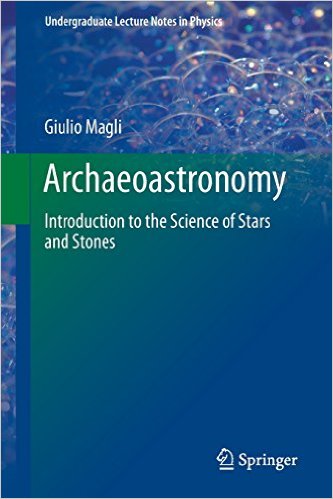- Belgique : mégalithes et cartes postales
- Carnac : une bande dessinée à caractère fantastique
- ECOSSE : Un cercle de pierre daté d'il y a 3500 ans créé de toute pièce par un fermier dans les années 90.
- Estrémadure : La sécheresse révèle une construction mégalithique vieille de 4000 ans.
- Haute-Savoie: Le dolmen de la Pierre aux Fées et le Campaniforme
- Morbihan : Ces Bretons veulent sauver leur menhir de 7 000 ans
- Mégalithisme et philatélie
- Russie : le complexe mégalithique de Vera Island
- Seine-et-Marne : retour sur une découverte mégalithique hors norme à Chamigny
- Un curieux guide des mégalithes
Archéoastronomie : introduction à une discipline fascinante
21/12/2015

![]() Sous le titre de « Archaeoastronomy : Introduction to the Science of Stars and Stones », Giulio Magli
, de l’Ecole d’architecture civile de Milan (Italie), vient de publier chez Springer une introduction à l’archéoastronomie qui aborde des sites de périodes variées et notamment, en matière de mégalithisme, le célébrissime site de Stonehenge.
Sous le titre de « Archaeoastronomy : Introduction to the Science of Stars and Stones », Giulio Magli
, de l’Ecole d’architecture civile de Milan (Italie), vient de publier chez Springer une introduction à l’archéoastronomie qui aborde des sites de périodes variées et notamment, en matière de mégalithisme, le célébrissime site de Stonehenge.

La couverture de cette publication
© 2016, ISBN 978-3-319-22881-5, 246 p. PRIX / 47,69 € pour l’édition brochée. Existe aussi sous forme d’eBook (32,12 €).
Rappelons que Giulio Magli était déjà l’auteur, en 2009, de « Mysteries and Discoveries of Archaeoastronomy. From Giza to Easter Island », également publié chez Springer.
On trouvera ci-dessous la présentation en anglais de l’ouvrage, telle que proposée par l’éditeur :
« This book provides the first complete, easy to read, up-to-date account of the fascinating discipline of archaeoastronomy, in which the relationship between ancient constructions and the sky is studied in order to gain a better understanding of the ideas of the architects of the past and of their religious and symbolic worlds. The book is divided into three sections, the first of which explores the past relations between astronomy and people, power, the afterworld, architecture, and landscape. The fundamentals of archaeoastronomy are then addressed in detail, with coverage of the celestial coordinates; the apparent motion of the Sun, Moon, stars, and planets; observation of celestial bodies at the horizon; the use of astronomical software in archaeoastronomy; and current methods for making and analyzing measurements. The final section reviews what archaeoastronomy can now tell us about the nature and purpose of such sites and structures as Stonehenge, the Pyramids of Giza, Chichen Itza, the Campus Martius, and the Valley of the Temples of Agrigento. In addition, a set of exercises is provided that can be performed using non-commercial free software, e.g., Google Earth or Stellarium, and will equip readers to conduct their own research. Readers will find the book an ideal introduction to what has become a wide-ranging multidisciplinary science ».